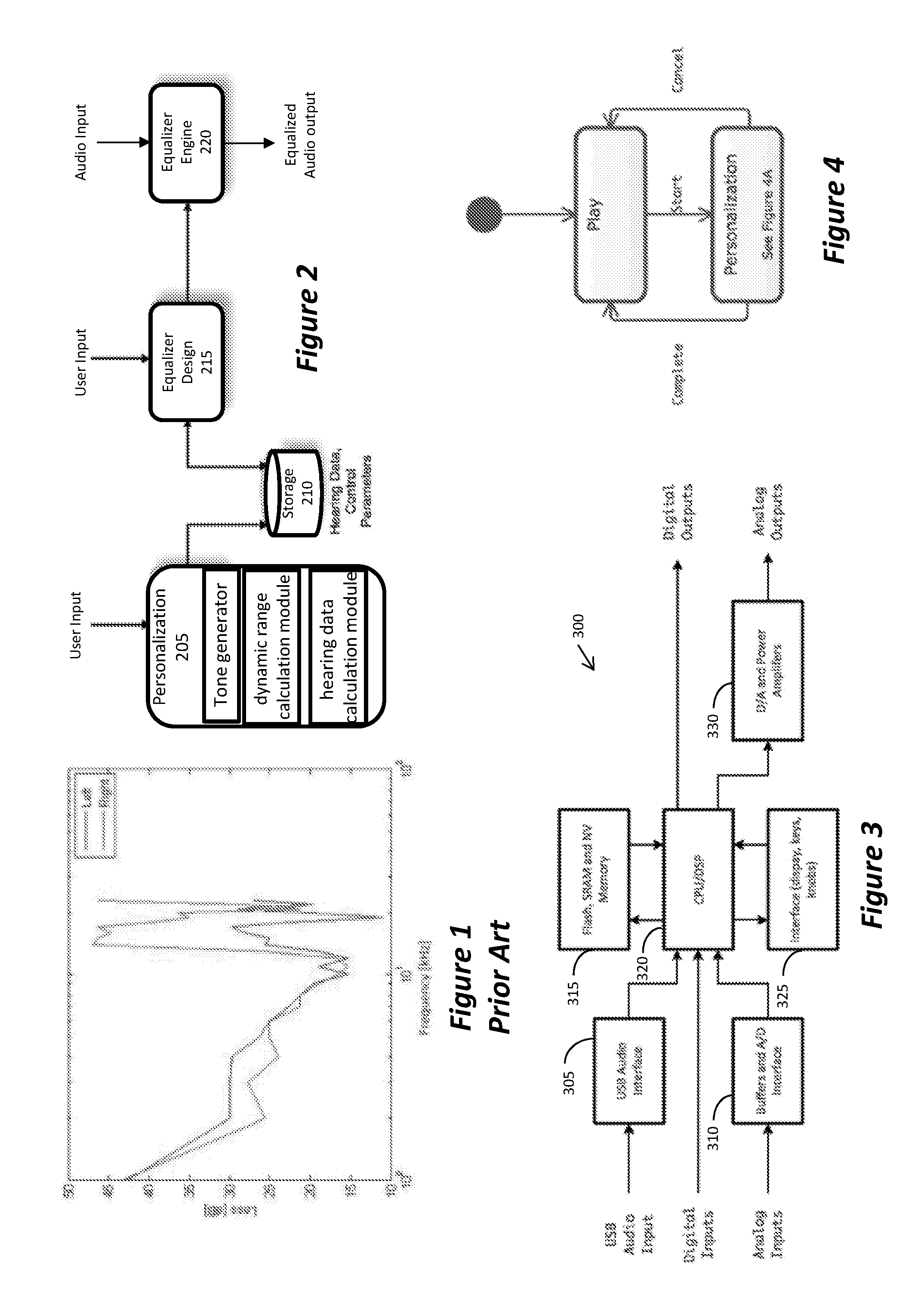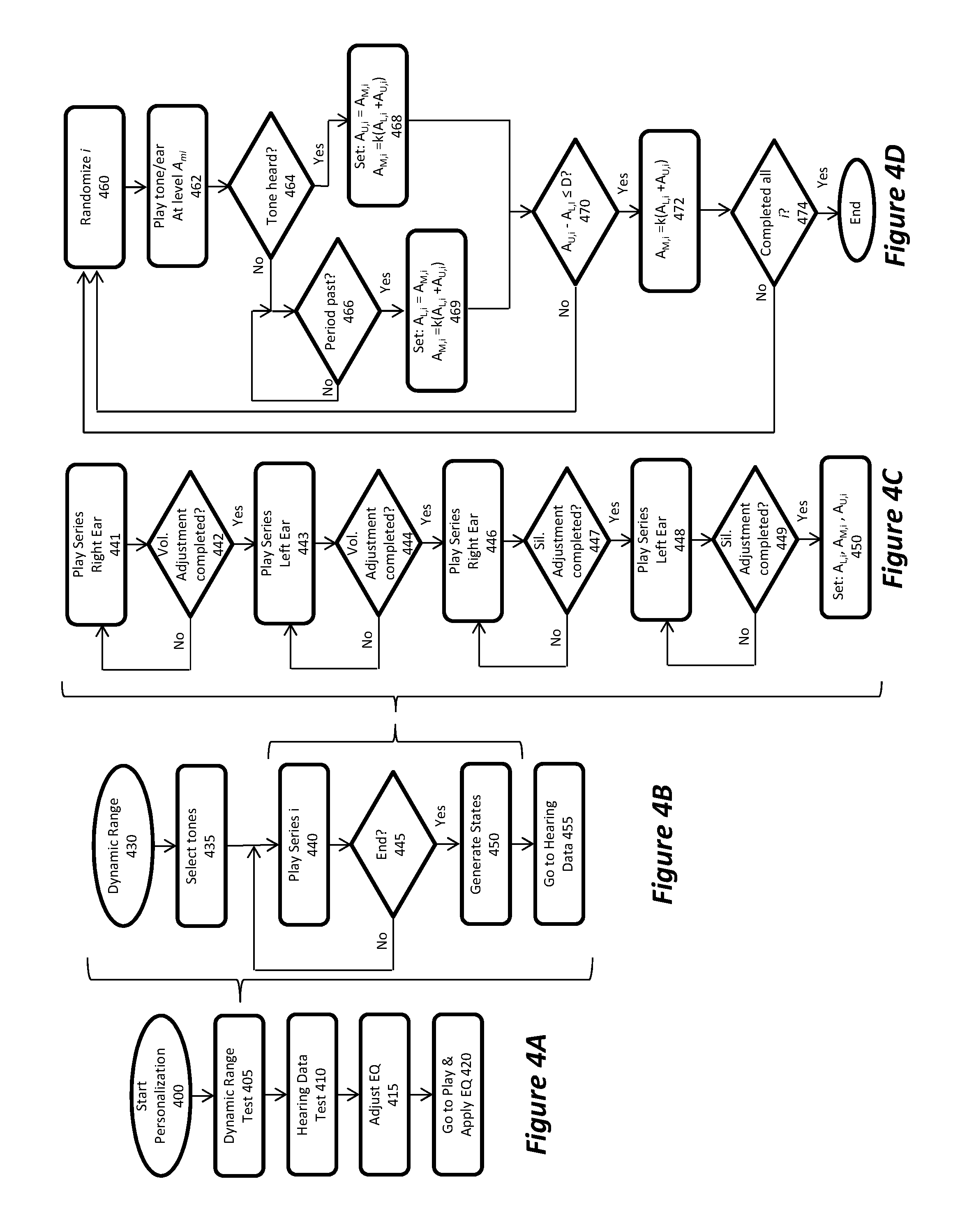System and method for improved audio perception
a technology of audio perception and system, applied in the field of audio signal processing, can solve the problems of user confusion, limited frequency range, and difficulty in adjusting the adjustment range of prior art equalizers in playback devices,
- Summary
- Abstract
- Description
- Claims
- Application Information
AI Technical Summary
Benefits of technology
Problems solved by technology
Method used
Image
Examples
example 1
[0049]The following is an example for adjusting the equalization of audio player in a manner individualized for a user. The operations involved include performing a dynamic range calculation to determine the dynamic hearing range of the user for a plurality of predetermined frequencies; performing a hearing data calculation to determine an upper and a lower level for each of the plurality of predetermined frequencies for each ear of the user individually; using the output of the hearing data calculations to adjust an equalization of an audio player to obtain a user tailored equalization; and applying the user tailored equalization to an audio signal prior to playing the audio file to the user.
[0050]FIG. 2 illustrates a block diagram of a signal flow for implementing this specific embodiment. In this embodiment, the audio signal personalization comprises several custom building blocks or modules. The modules may be implemented using Digital Signal Processing (DSP) and appropriate alg...
example 2
[0058]According to this embodiment, the modules of the invention are implemented in a specific hardware arrangement shown in FIG. 3. FIG. 3 is a hardware block diagram of the device 300 according to this specific example. In this example the device can accept various types of inputs:[0059]Analog Inputs[0060]Digital Inputs[0061]USB Audio Input
[0062]The analog input to the device is passed to buffer amplifiers, followed by a A / D (Analog to Digital) converters indicated as 310. The outputs of the A / D converters are sent to the CPU / DSP 320 as a digital stream.
[0063]The device can also accept pure digital audio streams from various sources (e.g., S / PDIF connection, optical or coax), and audio steams over USB connection via USB audio interface 305. These streams pass through appropriate buffering / conditioning circuits to the CPU / DSP 320.
[0064]All interface components 325 (buttons, keypad, switches, indicators, and the display) are connected to proper interfaces. These, in turn, provide th...
example 3
[0070]This example illustrates a logical operation of an embodiment of the invention. FIG. 4 is a master State Diagram, explaining the logical operation of the disclosed embodiment. As can be seen from FIG. 4, the method has two logical operational states: Personalization and Play. In Personalization state, the device can be personalized to the user or to a user-sounder pair. The user may repeat the personalization operation as often as necessary by starting its process via the device user interface, e.g., interface 325 in FIG. 3. At the end of the personalization procedure, the device is “adapted” to the user or user-sounder pair such that the sound-processing algorithm is optimized for both ears over the whole frequency range. The Personalization parameters are saved to the Non-Volatile memory, e.g., memory 315 of FIG. 3. The user can restart Personalization in the middle of the play state as well. The user may also abort Personalization and switch to the Play state. When this hap...
PUM
 Login to View More
Login to View More Abstract
Description
Claims
Application Information
 Login to View More
Login to View More - R&D
- Intellectual Property
- Life Sciences
- Materials
- Tech Scout
- Unparalleled Data Quality
- Higher Quality Content
- 60% Fewer Hallucinations
Browse by: Latest US Patents, China's latest patents, Technical Efficacy Thesaurus, Application Domain, Technology Topic, Popular Technical Reports.
© 2025 PatSnap. All rights reserved.Legal|Privacy policy|Modern Slavery Act Transparency Statement|Sitemap|About US| Contact US: help@patsnap.com



